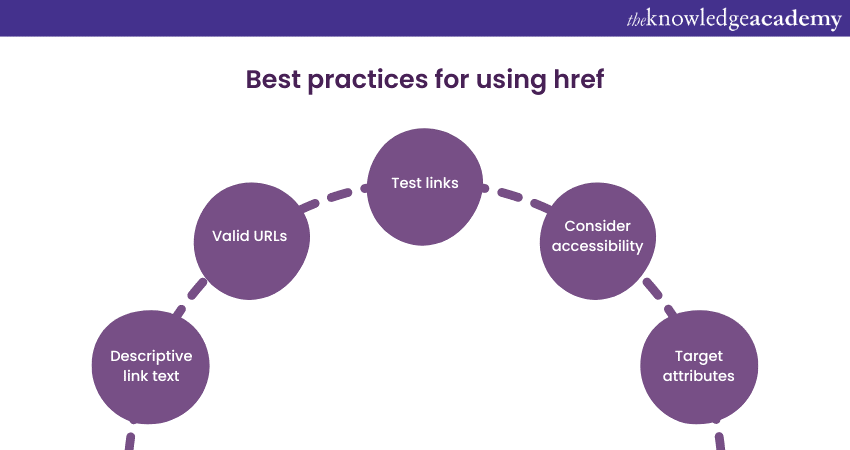We may not have the course you’re looking for. If you enquire or give us a call on 01344203999 and speak to our training experts, we may still be able to help with your training requirements.
We ensure quality, budget-alignment, and timely delivery by our expert instructors.

HTML (Hypertext Markup Language) lays the foundation for the web, allowing us to create hyperlinks to connect different web pages and resources. One of the most essential HTML elements for creating links is the anchor tag, represented as. The HTMLhref attribute defines the link's destination within the anchor tag.
1) Understanding the HTML Anchor () Tag
2) The href attribute explained
Understanding the HTML Anchor () tag
Unlock your potential in App & Web Development Training with our comprehensive training program!
The href attribute explained
The href attribute, short for "hypertext reference," is a vital element in HTML (Hypertext Markup Language) used to create functional hyperlinks. It essentially acts as a destination pointer, determining where a user will be directed when they interact with a hyperlink, typically enclosed within an anchor tag ().
The primary purpose of the href attribute is to specify the link's target. This can include linking to other web pages within the same website (using relative URLs), external websites (using absolute URLs), or even email addresses (using "mail to:" followed by the email address). Additionally, the href attribute can be used to link to downloadable files like PDFs or documents.
The href attribute is the key to making web content interactive and interconnected, allowing users to seamlessly navigate the web. Understanding how to use it effectively is essential for Web Designers and Developers, as it enhances User Experience and ensures the functionality of links, making information easily accessible and interactive on the internet.
Unlock your creativity and level up your skills with HTML5 Apps and Game Training today!
Absolute vs. relative URLs
Understanding the distinction between absolute and relative URLs is crucial when working with Web Development and HTML. These two types of URLs determine how browsers locate and display web resources, and they are used in the href attribute of Anchor tags () and other HTML elements.
Absolute URLs
Absolute URLs are the complete web addresses that specify the exact location of a resource on the internet. They include the protocol (e.g., "https://"), the domain name (e.g., "www.example.com"), and the path to the resource (e.g., "/page.html"). Absolute URLs are like GPS coordinates; they provide an exact location for the browser to reach, making them ideal for linking to external websites or resources hosted on different domains. However, they can be lengthy and less flexible if a website's structure changes.
Relative URLs
Relative URLs, on the other hand, specify the location of a resource relative to the current page's location. They are like giving directions to a friend based on your current position. For example, "../page.html" means "go up one level in the directory and find 'page.html'." Relative URLs are shorter and adapt to changes within a website's structure, making them suitable for linking to internal pages or resources within the same website.
HTML href Example
Let's explore practical HTML href examples to see how this attribute works in various scenarios
Basic Link
|
href="https://www.example.com">Visit Example.com |
In this simple example, we create a hyperlink to an external website, "https://www.example.com." When users click on the link text "Visit Example.com," their web browser will navigate to that URL.
External Website Link
|
href="https://www.google.com">Go to Google |
Here, we create another external link, this time directing users to Google's homepage. This illustrates how the href attribute can be used to connect your web page to other websites on the internet.
Internal Page Link
|
About Us |
In this example, we use a relative URL, "/about.html," to link to an internal page on the same website. Relative URLs are valuable for navigating within your website's structure without specifying the complete web address.
Email Link
|
href="mailto:info@example.com">Email Us |
This href example creates an email link. When users click "Email Us," it opens their default email client with a new email composition window, addressed to "info@example.com." This is a convenient way to encourage contact and communication.
Unlock your Web Development potential with Programming In HTML5 With JavaScript And CSS3 M20480 : Programming in HTML5, JavaScript, and CSS3 course today!
Best practices for using href

When using the href attribute in HTML to create links, it's essential to adhere to best practices to ensure optimal User Experience and web accessibility. Here are some key guidelines:
a) Descriptive link text: Ensure that your link text is clear and descriptive, conveying the destination or purpose of the link. This helps users understand where they'll go when they click it.
b) Valid URLs: Always use valid and properly formatted URLs in the href attribute. Broken or incorrect links can frustrate users and harm your website's credibility.
c) Test links: Regularly test your links to confirm they work correctly. This includes checking both internal and external links to ensure they lead to the intended destinations.
d) Consider accessibility: Make sure your links are accessible to all users, including those with disabilities. Use meaningful link text, and provide alternative text for non-text content, such as images used as links.
e) Target attributes: When linking to external websites, consider using target="_blank" to open the link in a new tab or window, allowing users to retain your site as a reference.
Conclusion
The HTML href attribute is like a key that unlocks the magic of web links. It helps us connect to websites, pages, emails, and files. By following best practices, we make our links clear, reliable, and user-friendly, making the web a better place for everyone.
Start your journey into the world of HTML today and shape the web of tomorrow. Join Introduction To HTML now!
Upcoming Programming & DevOps Resources Batches & Dates
Date
 Introduction to HTML
Introduction to HTML
Fri 23rd May 2025
Fri 25th Jul 2025
Fri 26th Sep 2025
Fri 28th Nov 2025






 Top Rated Course
Top Rated Course



 If you wish to make any changes to your course, please
If you wish to make any changes to your course, please


